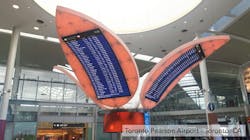As the primary transportation hubs of the cities they serve, airports depend on the ability to provide travelers with engaging and highly relevant information about where they are and where they need to go.
The smooth operation of airports necessitates that flight details, weather updates, and the location of amenities are communicated to travelers swiftly and effectively, so that they leave the airport having had an efficient and enjoyable experience. These important pieces of information are generally placed in central, easy to see locations, but there are countless unused areas in airports where other forms of messaging could live. These currently empty yet potentially lucrative areas are classified as dead space, and they are the next frontier digital signage hopes to revolutionize.
As travelers move about an airport concourse, they frequently pass through areas that have not been prioritized to the degree of the more central hubs. Not every hallway is elaborately decorated, and not every open area features distinctive artwork or signage. After all, when any structure is built -be it an airport, or a stadium, or an office building- the locations that are awarded the most attention in the building’s preparation are the ones that will receive the most attention in its operation. The more people that will be making use of a particular area upon its completion, the more resources will be dedicated to its construction. This helps to explain why dead space has been, well, dead. These locations are a bit out of the way, and therefore they are seen by a smaller percentage of airport guests. Fewer travelers visiting the area means fewer efforts dedicated to its development and beautification.
Defining Dead Space
To clarify, any wall, ceiling, or floor space which is unused or underutilized, within the publicly accessible areas of the airport concourse, can be considered dead space. The emptiness of these spaces could be due to an unwillingness to part with obsolete static fixtures or displays, or it could be a result of prioritizing more heavily trafficked areas. There is also a chance it stems from a simple lack of imagination. We need to collectively start thinking a bit bigger when it comes to space utilization in airports because potential growth opportunities are being left untapped. As Voltaire attested centuries before air travel even arrived, we must avoid allowing better to be the enemy of good. These dead spaces are not perfect, obviously, but that should not deter industrious marketers and enterprising artists from taking advantage. Let us not focus on what they fail to offer, but instead on what they do provide; namely, an opportunity. Activating these dead spaces with engaging and unique visual display solutions will not only provide lucrative opportunities for advertisers, but it can also serve to revitalize an entire airport experience.
How to Utilize Dead Space
One solution that airports across the globe are using to accomplish the goal of revitalizing dead space is with LED displays. These electrifying features inspire consumers, inform travelers, and enchant imaginations, driving communication forward in this age of rapid technological innovation. Through the installation of vibrant LED signage, less-prominent, revenue-dormant areas can become growth areas to catch the eyes of consumers in a more private way. To illustrate, consider how many visual messages a traveler is exposed to as they sit in a well-developed central hub of an airport terminal. He or she will see countless digital signs pushing restaurant specials or duty-free sales on jewelry or high-end luggage. Kiosks will advertise their merchandise as airport personnel whisk past one their way from one terminal to the next. These areas are hectic and filled with distractions, and it is a marvel any travelers are able to focus on finding their flight information with so much going on around them. Indeed, our attention spans are not as generous as they once were. In the hustle of crowded areas, guards are up, priorities are set, and nobody has time to read or engage with anything that is not immediately necessary.
This is where the potential of dead space most vividly comes into view. Often it is the quietest places where consumers are most willing to lend large portions of their focus. As travelers proceed away from the hubbub of food courts and central terminals down quieter hallways and past subdued dining zones, they relax. They become willing to take a second to investigate an intriguing piece of art, or to read an informational placard, or to interact with marketing signage. Their attention is open for business, so to speak.
LED Displays as Revenue Generators
Incorporating LED displays into previously disengaged dead space areas will provide media where travelers do not expect it. For that reason, it is far more effective than traditional marketing media found in busier areas. Marketing expenditure is all about the return on investment a campaign can generate, right? Why pay top dollar to put content in the most expensive airport locations when your business can receive a far greater ROI by taking advantage of (perhaps wrongly) perceived “lesser” spaces? Airports are often cavernous places, but all this space is rarely used effectively. There exists an incredible opportunity for savvy businesses to efficiently promote their content without having to spend an exorbitant amount. The door is open to a vast group of potential consumers who are not accustomed to being courted. These audiences are essentially captive. They have to walk down hallways to reach their terminal, so if your content is on display, they really have no choice but to be exposed to it. From that point on, it is up to you and your content generators to best take advantage of the attention your display receives.
In these spaces, digital LED signage is incomparably more versatile than traditional standard signage. Airport staff regularly dress up their concourses to match the seasons, and advertisers always aim to keep marketing content up to date. Accomplishing these tasks with static installations has long been a lead-footed endeavor. Digital signage allows for content to be changed on the fly, rendering obsolete the irksome routine of continually purchasing and replacing static signage.
LED Displays as Art
Beyond just their application as a revenue-generator for marketers, LED displays are also remarkably suited to function as artistic centerpieces. Art does not always need to serve a purpose to justify its existence, but LED displays certainly are capable of going above and beyond in doing so. Consider “The Flower” found in Toronto’s Pearson Airport. The stunning LED feature dominates a central gathering area with its beauty while also serving the practical purpose of providing flight information and weather details to busy travelers. The LED feature has transformed what once was dead space into perhaps the most highly-trafficked location in the concourse. Airport personnel report they frequently overhear travelers saying “Meet me at The Flower,” and claim the installation has enlivened airport staff and guests alike.
Another example can be found in everything that Changi Airport in Singapore does with their LED features. One is a massive 70-meter fine-pitch video wall that illuminates the security screening area of Terminal 4 with brilliantly colored content on a 50-minute loop. Travelers are provided engaging visual relief from the dolorous yet necessary task of waiting in a security line, and as a result the tedious process is made far more pleasant and efficient. The second installation is found in the airport’s Heritage Zone, where the display shows a film celebrating traditional aspects of Singapore’s rich history and vibrant culture.
There’s quite a difference between a traveler departing with the impression that a particular portion of an airport is beautiful, and departing with the impression that the airport in its entirety is beautiful. The development of dead space is the final step airports need to take in order to create a fully immersive experience. Though airports are inherently gateways in practice, LED displays give them the potential to be so much more than that. Airports are reflections of their cities and their regions, and concourse designers would do well to prioritize an airport experience as fulfilling and captivating as the time spent in their city.
The Next Steps
It is relatively easy to understand the first layers of why LED displays have the potential to energize underutilized dead space, as their brilliance is eye-catching no matter where they are positioned. If your content is static, the versatility of your digital display is not being maximized. Integrating vibrant content-populated displays with smart platforms gives marketers and artists the ability to learn about who makes up their audience. Examples of this integrated tech include sophisticated cameras and beacons that can recognize and identify key traits of a viewing audience in order to quantify who exactly is giving the content the most attention. Is the content being viewed mostly by younger adults standing alone, or by older folks checking out the display with a partner? This kind of information is exceptionally valuable to marketers, artists, and other content managers because it allows them to specifically tailor their content strategy to their audience. Additionally, digital displays are capable of providing an audience a level of interactivity unmatched by traditional static signage. The best way to tell story is to allow viewers to become a part of it. Involving them in the story will help guarantee a personal connection is built.
Media, in its most creative forms, should create a special impression on an audience. This impression is strongest when it is made with the day’s most advanced display technology. When once travelers found dead space in airports to be utterly ignorable, with the installation of LED display technology these areas jump to life. The days of empty darkness and uninspired static messaging in your revenue-dormant areas is over. Marketers and airport administrators should be trying to squeeze as much revenue out of their concourse as possible. Taking advantage of dead space is the first step in accomplishing that.
Joe’ Lloyd is an evangelist and practitioner of content marketing in the B2B space. With over 15 years working in technology, her career has spanned both client services and marketing with a strong focus in the retail world. As the Vice President of Global Marketing for NanoLumens, Joe’ is an outspoken proponent of social selling, networking and public relations, and is dedicated to providing marketing with a strong, dependable ROI.
About the Author

